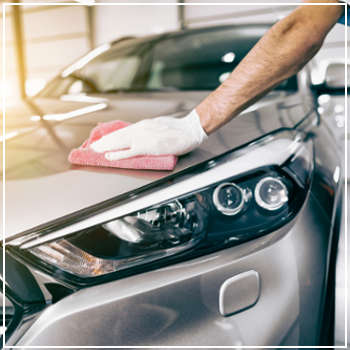 Even though doing a DIY paint touch-up or applying car wax might seem like a quick fix, the outcomes aren’t always ideal. Particularly when it comes to painting, you might encounter problems with adhesion or end up with a rough, grainy look if you're not cautious. Professional detailing services, such as waxing, offer superior results because they use high-quality materials and techniques, ensuring your vehicle remains shielded from environmental damage while keeping its gleaming appearance intact.
Even though doing a DIY paint touch-up or applying car wax might seem like a quick fix, the outcomes aren’t always ideal. Particularly when it comes to painting, you might encounter problems with adhesion or end up with a rough, grainy look if you're not cautious. Professional detailing services, such as waxing, offer superior results because they use high-quality materials and techniques, ensuring your vehicle remains shielded from environmental damage while keeping its gleaming appearance intact.
Why Wax Your Car and How Often Should You Do It?
Waxing is essential for preserving your car's exterior aesthetics. It acts as a protective layer, blocking harmful environmental elements like UV rays, tree sap, bird droppings, and road debris, and helps prevent rust. Waxing also ensures that rainwater beads up and rolls off the surface, maintaining the freshness of your car’s paintwork. Neglecting regular waxing will eventually lead to a dull, faded look over time.
For optimal results, you should aim to wax your car approximately every three months. However, if you live in extreme climates—whether very hot or very cold—you may need more frequent treatments due to increased wear and tear. Factors such as driving over salt-laden roads during winter, living in areas with high pollution levels, parking under trees (which exposes your car to sap and bird droppings), or leaving your car outdoors daily can all necessitate additional wax applications throughout the year.
It’s also important to check your car’s exterior every six weeks to see if the wax has worn off. The type of wax used affects how long it lasts; natural, carnauba-based waxes tend to last shorter compared to synthetic formulas that can provide protection for up to a year.
During a professional detailing session, your car will undergo thorough cleaning. This includes washing and drying the body, removing dirt and grease from the wheels, cleaning the trunk seals, windows, and door jambs. Once the vehicle is free of any grime and the paintwork has been polished, a wax treatment along with a sealant will be applied to enhance its shine and durability.
When Should You Seek Professional Waxing Services?
Professional waxing offers unparalleled quality and thoroughness compared to amateur efforts. Consider booking an appointment with DaSilva’s Auto Body under the following scenarios:
Your Car Fails the Water Bead Test
This test is straightforward: sprinkle or spray water onto your car’s surface. If the wax is effective, the water will form distinct beads that roll off easily. Conversely, if the water spreads out into sheets or streaks, it indicates that the wax has worn off and requires replacement.
You Notice Dry Paint
If you spot cracks in the paint finish, especially after prolonged exposure to sunlight, this suggests severe UV damage. At this point, the wax has likely degraded entirely, and the clear coat isn't protecting the paint anymore, leading to moisture loss in the paint layers.
You Hear a Squeaky Noise
To assess the condition of your car’s surface, try pressing a folded towel firmly against the exterior and moving it in circular motions. If you hear a squeak or squeal, it means the wax has thinned significantly. Ideally, the towel should glide smoothly across the surface without making any sound, regardless of the pressure applied.
You See Scratches
Waxing typically minimizes minor scratches, making them less noticeable. Therefore, if these scratches become more apparent, it’s a sign that the wax has worn away and needs either spot touch-ups or a full reapplication.
For comprehensive detailing or enhanced rust protection, trust DaSilva’s Auto Body to safeguard your vehicle against the elements. To arrange a professional waxing service or a complete exterior detailing, get in touch with our Naugatuck location today.
SHAOXING KEQIAO FANEVER IMPORT AND EXPORT CO., LTD , https://www.sxfanever.com
